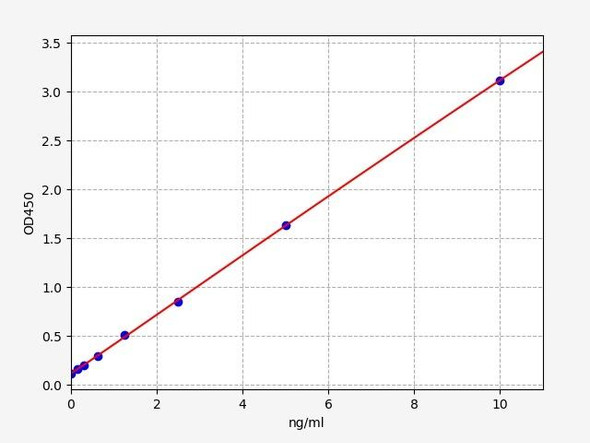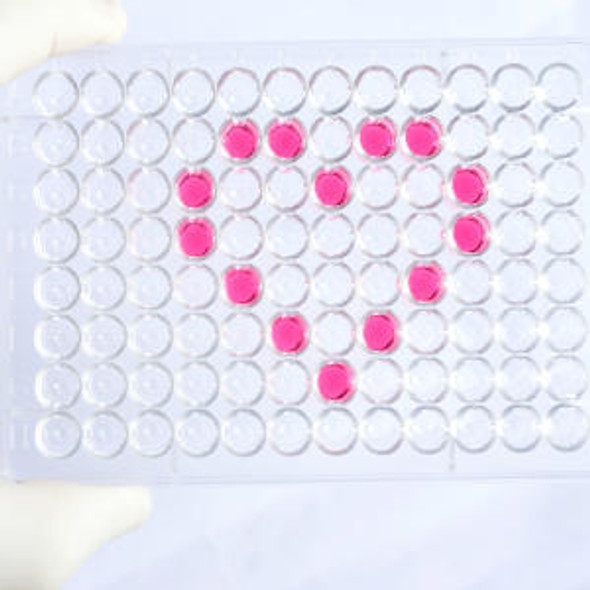Human LCAT (Lecithin-Cholesterol Acyltransferase) ELISA Kit (HUES03320)
- SKU:
- HUES03320
- Product Type:
- ELISA Kit
- Size:
- 96 Assays
- Uniprot:
- P04180
- Sensitivity:
- 0.94ng/mL
- Range:
- 1.56-100ng/mL
- ELISA Type:
- Sandwich
- Synonyms:
- phosphatidylcholine-sterol O-acyltransferase
- Reactivity:
- Human
- Sample Type:
- Serum, plasma and other biological fluids
- Research Area:
- Metabolism
Description
Human LCAT (Lecithin-Cholesterol Acyltransferase) ELISA Kit
The Human LCAT (Lecithin-Cholesterol Acyltransferase) ELISA Kit is specifically designed to accurately measure LCAT levels in human serum, plasma, and cell culture supernatants. This kit offers exceptional sensitivity and specificity, ensuring precise and reproducible results for a variety of research purposes.LCAT is a key enzyme involved in the metabolism of cholesterol, playing a crucial role in the formation of HDL (good cholesterol) and the prevention of atherosclerosis.
Dysregulation of LCAT activity has been linked to cardiovascular diseases, making it a valuable biomarker for studying these conditions and developing potential treatments.By using the Human LCAT ELISA Kit, researchers can gain valuable insights into cholesterol metabolism and cardiovascular health, contributing to advancements in the field of lipid research and the development of innovative therapeutic strategies.
| Assay type: | Sandwich |
| Format: | 96T |
| Assay time: | 4.5h |
| Reactivity: | Human |
| Detection Method: | Colormetric |
| Detection Range: | 1.56-100 ng/mL |
| Sensitivity: | 0.94 ng/mL |
| Sample Volume Required Per Well: | 100µL |
| Sample Type: | Serum, plasma and other biological fluids |
| Specificity: | This kit recognizes Human LCAT in samples. No significant cross-reactivity or interference between Human LCAT and analogues was observed. |
This ELISA kit uses Sandwich-ELISA as the method. The micro ELISA plate provided in this kit has been pre-coated with an antibody specific to Human LCAT. Standards or samples are added to the appropriate micro ELISA plate wells and combined with the specific antibody. Then a biotinylated detection antibody specific for Human LCAT and Avidin-Horseradish Peroxidase (HRP) conjugate are added to each micro plate well successively and incubated. Free components are washed away. The substrate solution is added to each well. Only those wells that contain Human LCAT, biotinylated detection antibody and Avidin-HRP conjugate will appear blue in color. The enzyme-substrate reaction is terminated by adding Stop Solution and the color turns yellow. The optical density (OD) is measured spectrophotometrically at a wavelength of 450 nm ± 2 nm. The OD value is proportional to the concentration of Human LCAT. The concentration of Human LCAT in samples can be calculated by comparing the OD of the samples to the standard curve.
| UniProt Protein Function: | LCAT: Central enzyme in the extracellular metabolism of plasma lipoproteins. Synthesized mainly in the liver and secreted into plasma where it converts cholesterol and phosphatidylcholines (lecithins) to cholesteryl esters and lysophosphatidylcholines on the surface of high and low density lipoproteins (HDLs and LDLs). The cholesterol ester is then transported back to the liver. Has a preference for plasma 16:0-18:2 or 18:O-18:2 phosphatidylcholines. Also produced in the brain by primary astrocytes, and esterifies free cholesterol on nascent APOE-containing lipoproteins secreted from glia and influences cerebral spinal fluid (CSF) APOE- and APOA1 levels. Together with APOE and the cholesterol transporter ABCA1, plays a key role in the maturation of glial-derived, nascent lipoproteins. Required for remodeling high-density lipoprotein particles into their spherical forms. Defects in LCAT are the cause of lecithin-cholesterol acyltransferase deficiency (LCATD); also called Norum disease. LCATD is a disorder of lipoprotein metabolism characterized by inadequate esterification of plasmatic cholesterol. Two clinical forms are recognized: familial LCAT deficiency and fish-eye disease. Familial LCAT deficiency is associated with a complete absence of alpha and beta LCAT activities and results in esterification anomalies involving both HDL (alpha-LCAT activity) and LDL (beta-LCAT activity). It causes a typical triad of diffuse corneal opacities, target cell hemolytic anemia, and proteinuria with renal failure. Defects in LCAT are a cause of fish-eye disease (FED); also known as dyslipoproteinemic corneal dystrophy or alpha-LCAT deficiency. FED is due to a partial LCAT deficiency that affects only alpha-LCAT activity. It is characterized by low plasma HDL and corneal opacities due to accumulation of cholesterol deposits in the cornea ('fish-eye'). Belongs to the AB hydrolase superfamily. Lipase family. |
| UniProt Protein Details: | Protein type:Secreted; Secreted, signal peptide; Lipid Metabolism - glycerophospholipid; EC 2. 3. 1. 43; Transferase Chromosomal Location of Human Ortholog: 16q22. 1 Cellular Component: extracellular region; extracellular space Molecular Function:apolipoprotein A-I binding; phosphatidylcholine-sterol O-acyltransferase activity; protein binding Biological Process: cholesterol homeostasis; cholesterol metabolic process; cholesterol transport; lipoprotein metabolic process; phosphatidylcholine biosynthetic process; phosphatidylcholine metabolic process; phospholipid metabolic process; reverse cholesterol transport Disease: Fish-eye Disease; Lecithin:cholesterol Acyltransferase Deficiency |
| NCBI Summary: | This gene encodes the extracellular cholesterol esterifying enzyme, lecithin-cholesterol acyltransferase. The esterification of cholesterol is required for cholesterol transport. Mutations in this gene have been found to cause fish-eye disease as well as LCAT deficiency. [provided by RefSeq, Jul 2008] |
| UniProt Code: | P04180 |
| NCBI GenInfo Identifier: | 125993 |
| NCBI Gene ID: | 3931 |
| NCBI Accession: | P04180. 1 |
| UniProt Secondary Accession: | P04180,Q53XQ3, |
| UniProt Related Accession: | P04180 |
| Molecular Weight: | 49,578 Da |
| NCBI Full Name: | Phosphatidylcholine-sterol acyltransferase |
| NCBI Synonym Full Names: | lecithin-cholesterol acyltransferase |
| NCBI Official Symbol: | LCAT |
| NCBI Protein Information: | phosphatidylcholine-sterol acyltransferase |
| UniProt Protein Name: | Phosphatidylcholine-sterol acyltransferase |
| UniProt Synonym Protein Names: | Lecithin-cholesterol acyltransferase; Phospholipid-cholesterol acyltransferase |
| UniProt Gene Name: | LCAT |
| UniProt Entry Name: | LCAT_HUMAN |
As the OD values of the standard curve may vary according to the conditions of the actual assay performance (e. g. operator, pipetting technique, washing technique or temperature effects), the operator should establish a standard curve for each test. Typical standard curve and data is provided below for reference only.
| Concentration (ng/mL) | O.D | Average | Corrected |
| 100 | 2.281 2.313 | 2.297 | 2.221 |
| 50 | 1.536 1.556 | 1.546 | 1.47 |
| 25 | 0.923 0.913 | 0.918 | 0.842 |
| 12.5 | 0.424 0.444 | 0.434 | 0.358 |
| 6.25 | 0.25 0.238 | 0.244 | 0.168 |
| 3.13 | 0.176 0.162 | 0.169 | 0.093 |
| 1.56 | 0.117 0.131 | 0.124 | 0.048 |
| 0 | 0.068 0.084 | 0.076 | -- |
Precision
Intra-assay Precision (Precision within an assay): 3 samples with low, mid range and high level Human LCAT were tested 20 times on one plate, respectively.
Inter-assay Precision (Precision between assays): 3 samples with low, mid range and high level Human LCAT were tested on 3 different plates, 20 replicates in each plate.
| Intra-assay Precision | Inter-assay Precision | |||||
| Sample | 1 | 2 | 3 | 1 | 2 | 3 |
| n | 20 | 20 | 20 | 20 | 20 | 20 |
| Mean (ng/mL) | 5.29 | 9.94 | 47.48 | 5.09 | 9.00 | 43.49 |
| Standard deviation | 0.33 | 0.54 | 1.78 | 0.34 | 0.42 | 2.29 |
| C V (%) | 6.24 | 5.43 | 3.75 | 6.68 | 4.67 | 5.27 |
Recovery
The recovery of Human LCAT spiked at three different levels in samples throughout the range of the assay was evaluated in various matrices.
| Sample Type | Range (%) | Average Recovery (%) |
| Serum (n=5) | 91-107 | 98 |
| EDTA plasma (n=5) | 91-106 | 98 |
| Cell culture media (n=5) | 87-99 | 93 |
Linearity
Samples were spiked with high concentrations of Human LCAT and diluted with Reference Standard & Sample Diluent to produce samples with values within the range of the assay.
| Serum (n=5) | EDTA plasma (n=5) | Cell culture media (n=5) | ||
| 1:2 | Range (%) | 87-100 | 97-109 | 99-110 |
| Average (%) | 94 | 103 | 105 | |
| 1:4 | Range (%) | 91-108 | 81-92 | 83-93 |
| Average (%) | 99 | 87 | 88 | |
| 1:8 | Range (%) | 90-103 | 83-92 | 87-100 |
| Average (%) | 97 | 87 | 94 | |
| 1:16 | Range (%) | 86-98 | 80-92 | 88-99 |
| Average (%) | 93 | 85 | 93 |
An unopened kit can be stored at 4°C for 1 month. If the kit is not used within 1 month, store the items separately according to the following conditions once the kit is received.
| Item | Specifications | Storage |
| Micro ELISA Plate(Dismountable) | 8 wells ×12 strips | -20°C, 6 months |
| Reference Standard | 2 vials | |
| Concentrated Biotinylated Detection Ab (100×) | 1 vial, 120 µL | |
| Concentrated HRP Conjugate (100×) | 1 vial, 120 µL | -20°C(shading light), 6 months |
| Reference Standard & Sample Diluent | 1 vial, 20 mL | 4°C, 6 months |
| Biotinylated Detection Ab Diluent | 1 vial, 14 mL | |
| HRP Conjugate Diluent | 1 vial, 14 mL | |
| Concentrated Wash Buffer (25×) | 1 vial, 30 mL | |
| Substrate Reagent | 1 vial, 10 mL | 4°C(shading light) |
| Stop Solution | 1 vial, 10 mL | 4°C |
| Plate Sealer | 5 pieces | |
| Product Description | 1 copy | |
| Certificate of Analysis | 1 copy |
- Set standard, test sample and control (zero) wells on the pre-coated plate and record theirpositions. It is recommended to measure each standard and sample in duplicate. Note: addall solutions to the bottom of the plate wells while avoiding contact with the well walls. Ensuresolutions do not foam when adding to the wells.
- Aliquot 100µl of standard solutions into the standard wells.
- Add 100µl of Sample / Standard dilution buffer into the control (zero) well.
- Add 100µl of properly diluted sample (serum, plasma, tissue homogenates and otherbiological fluids) into test sample wells.
- Cover the plate with the sealer provided in the kit and incubate for 90 min at 37°C.
- Aspirate the liquid from each well, do not wash. Immediately add 100µL of BiotinylatedDetection Ab working solution to each well. Cover the plate with a plate seal and gently mix. Incubate for 1 hour at 37°C.
- Aspirate or decant the solution from the plate and add 350µL of wash buffer to each welland incubate for 1-2 minutes at room temperature. Aspirate the solution from each well andclap the plate on absorbent filter paper to dry. Repeat this process 3 times. Note: a microplatewasher can be used in this step and other wash steps.
- Add 100µL of HRP Conjugate working solution to each well. Cover with a plate seal andincubate for 30 min at 37°C.
- Aspirate or decant the solution from each well. Repeat the wash process for five times asconducted in step 7.
- Add 90µL of Substrate Reagent to each well. Cover with a new plate seal and incubate forapproximately 15 min at 37°C. Protect the plate from light. Note: the reaction time can beshortened or extended according to the actual color change, but not by more than 30min.
- Add 50 µL of Stop Solution to each well. Note: Adding the stop solution should be done inthe same order as the substrate solution.
- Determine the optical density (OD value) of each well immediately with a microplate readerset at 450 nm.






